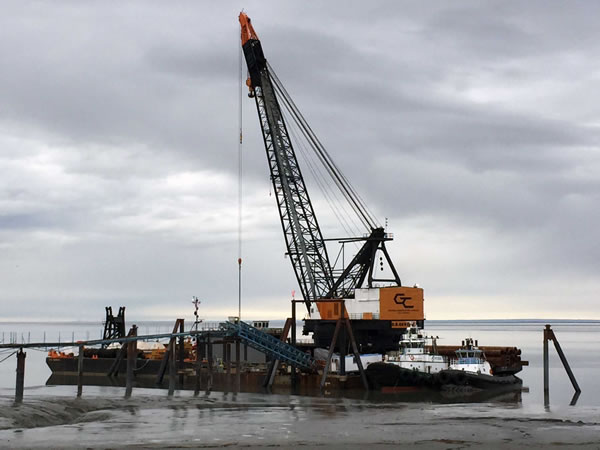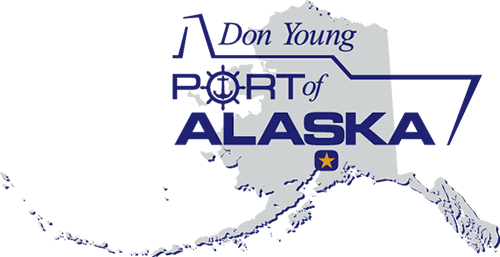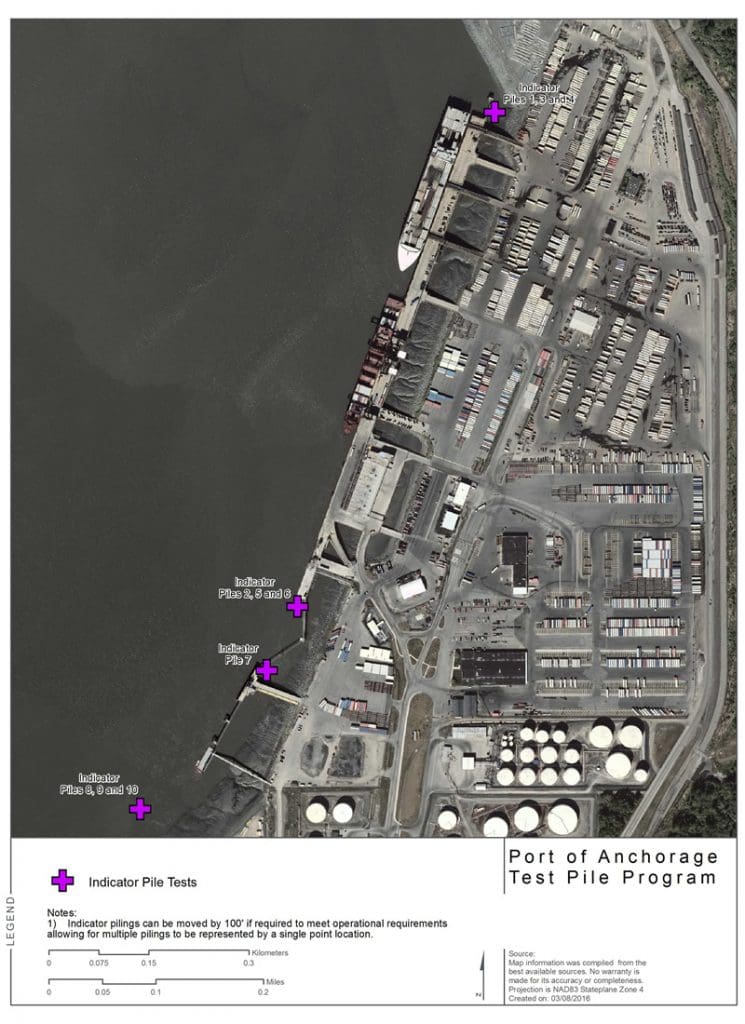Anchorage Port Modernization Program Test Pile Program Report of Findings
Prepared by: CH2M Engineers, Inc. Anchorage, Alaska
October 17, 2016
Introduction and Project Purpose
The Port of Anchorage (POA) is identifying and updating plans for modernizing its facilities through theAnchorage Port Modernization Program (APMP). An initial step in the APMP was implementation of a Test Pile Program (TPP), which involved a geotechnical investigation and the installation of 10 48-inch indicator pipe piles (IPs) in the area of future APMP development. This Report of Findings summarizes information from these TPP investigations and provides recommendations for future APMP permitting, design, and construction.
The project replicated the concept pile design and marine permit conditions. The geotechnical investigation provided detailed soil characterization in the near‐shore marine soils. Pile installation validated the concept pile design assumptions by collecting information on design capacity, pile drivability, and other variables in proximity to the planned APMP wharf structures; collecting data on noise levels produced during pile installation in the waters of Knik Arm; and testing noise attenuation systems (NASs) to reduce in‐water noise levels.
 Download Full Report - pdf
Download Full Report - pdf
Anchorage Port Modernization Program Test Pile Program Municipality of Anchorage Port of Anchorage
Prepared by: Kiewit Infrastructure Group
August 1, 2016 (updated Sept. 20, 2016)
Introduction and Construction Summary
The primary purpose of the Anchorage Port Modernization Program (APMP) Test Pile Program was to evaluate the performance of the installation equipment and methods under conditions similar to what will be used for production pile installation. In doing so, the following information was collected and evaluated from the test program which will help to establish tentative pile installation criteria:
- Monitoring of hydro-acoustic noise made by vibratory and impact pile driving.
- Testing of alternative noise abatement systems through use of a confined bubble curtain and resonator system.
- Performance of the pile driving equipment with regard to hydro-acoustic noise, relative driving stresses and transferred energy.
- Pile drivability, the effectiveness of pile driving equipment, installation procedures, and developing data to help determine production pile toe elevations.
- Marine mammal behavior during project activities, specifically Beluga Whales.
 Download Full Report - 40MB pdf
Download Full Report - 40MB pdf
Port of Anchorage Test Pile Program Geotechnical Data Report
Prepared by: Golder Associates Inc.
February 15, 2016 (with errata 1)
Introduction and Project Description
Golder Associates Inc. (Golder) has been contracted by Kiewit Infrastructure West Co. (Kiewit) to perform a geotechnical field exploration for the Municipality of Anchorage’s Port Modernization Program (APMP). This effort was to provide geotechnical information to support the design and permitting efforts for Kiewit’s forthcoming Test Pile Program. Throughout this project, Golder coordinated with Kiewit, the Port of Anchorage (POA), CH2M (POA project managers), and HDR (CH2M representatives).
This data report provides the results of Golder’s geotechnical field exploration, laboratory testing, and data collected from Vibrating Wire Piezometers (VWPs). The work plan was developed by Golder and submitted to Kiewit as the document titled “Port of Anchorage Geotechnical Exploration - Final Work plan” dated September 23, 2015. This Final Work plan was the culmination of scoping meetings and multiple addendums initiated by the Municipality’s Invitation To Bid (ITB) No. 2015C037, dated May 1, 2015.
 Download Full Report - 13MB pdf
Download Full Report - 13MB pdf
Test Pile Program
 Test Pile Program Fact Sheet - pdf
Test Pile Program Fact Sheet - pdf
 Test Pile Program In‐air Noise and Ground‐borne Vibration Analysis Monitoring Report - Full Report – pdf
Test Pile Program In‐air Noise and Ground‐borne Vibration Analysis Monitoring Report - Full Report – pdf
The POA is implementing the TPP to collect critical design information, investigate construction methods, and identify potential impacts that may occur when full APMP construction begins. This is an important step that will allow the POA to identify and address potential issues in advance of APMP construction activities.
One area that will be investigated during the TPP is the effect of in-water and in-air noise. The POA has been working closely with the National Marine Fisheries Service to identify mitigation measures and in-water noise data collection techniques to be implemented during the TPP. These measures will not only protect the beluga whale during TPP construction activities, but, more important, will identify and verify potential mitigation measures that may be effective during the full APMP construction program. Potential in-air noise impacts will also be evaluated during the TPP.

DB General (barge and crane) has arrived at the Port
In-air Noise Monitoring
The POA recognizes that any construction project has the potential to impact workers and nearby residents. During the TPP, the POA will monitor in-air noise levels at key locations within and adjacent to POA property during pile-driving activities to help determine the affects of pile-driving noise. Noise measurements will be taken to determine potential impacts to POA tenants and workers, the Cherry Hill neighborhood on Joint Base Elmendorf-Richardson, and Government Hill. These measurements will include continuous noise readings at a set location, combined with spot readings taken throughout the POA property and within/adjacent to the two nearby neighborhoods during construction activities. A continuous noise monitor will be set up on the bluff immediately adjacent to the Government Hill neighborhood for the duration of the TPP. Baseline or ambient noise levels will also be sampled prior to the start of TPP construction to serve as a basis of comparison and to evaluate increases associated directly with pile-driving operations.
The Municipality of Anchorage (MOA) noise ordinance (Anchorage Municipal Code 15.70) establishes allowable noise levels typically associated with specified activities (i.e., construction), restricted daily and seasonal time frames, and associated land uses. Allowable noise levels are different for different land uses. In addition, a noise permit can allow for a temporary increase in allowable noise levels or allow an event to occur at a time that it normally would not be allowed. The TPP noise monitoring program will help determine if pile-driving noise exceeds allowable noise levels and what actions may be necessary during future construction activities. (For more information on MOA’s Municipal Noise Ordinance and allowable noise levels, visit http://www.muni.org/Departments/health/Admin/environment/FSS/Pages/fssnoise.aspx.)
At the conclusion of the TPP, the POA will know more about the potential for in-air noise effects and will be able to consider actions to address those effects during upcoming APMP construction activities.
Next Steps
The 30-day window for test pile construction is anticipated to begin April 24, 2016. Ten piles will be installed, with each pile taking between 3 and 4 hours to install.
During the TPP, the POA will provide updates at regularly scheduled Government Hill Community Council meetings (http://communitycouncils.org/servlet/content/17.html), post updates on the POA website, and send out weekly updates via e-mail.
Test Pile Program Updates
Sign Up For E-mail Updates
Construction concerns? Let us know at 907-379-9979.




